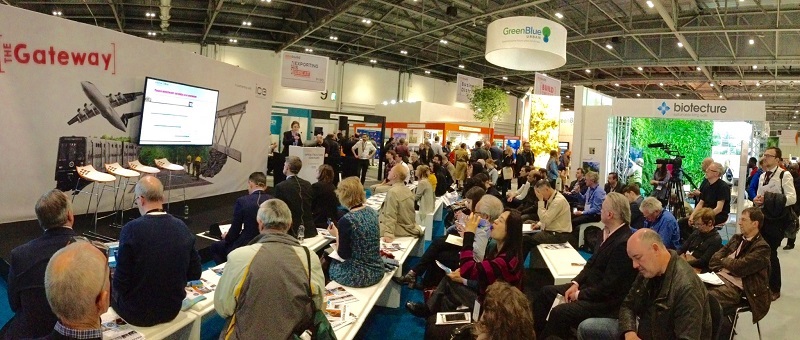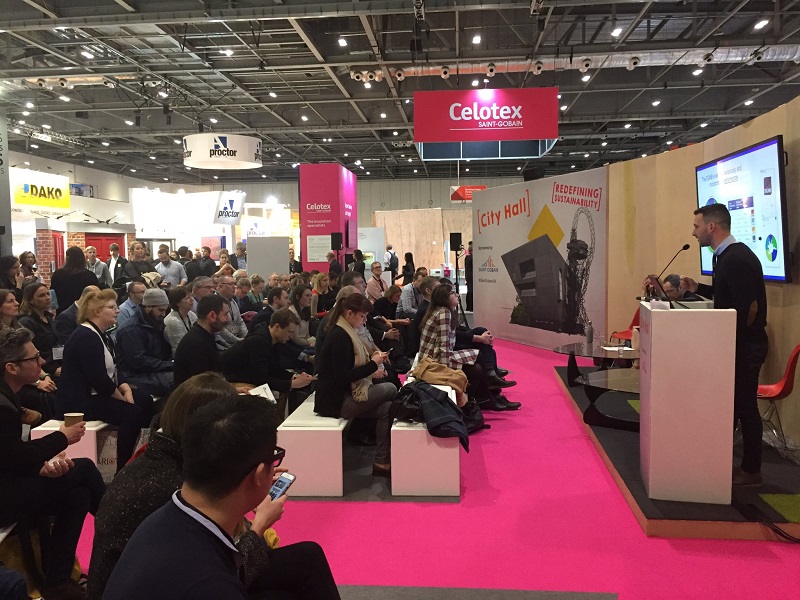Ecobuild 2017
In March 2017, Designing Buildings Wiki went to London’s Excel Centre for EcoBuild, the UK’s largest construction and energy event.
In the main arena, hosted by the BBC’s Arts Editor, Will Gompertz, the first conference session was on the subject of whether the London Mayor’s affordable housing requirements are the best way to tackle the housing crisis.
Jules Pipe, Deputy Mayor, Planning Regeneration and Skills for the Greater London Authority, asserted that the Mayor was still aiming for 50% affordable homes on all new developments. He said that policies being examined included embedding the requirement for affordable homes into land values, and speeding up developments that fit the correct criteria.
Pipe stated that the London Living Rent had been calculated based on a maximum of £60,000 household income.
Ben Derbyshire, Chair, HTA Design and RIBA President-Elect, said the RIBA membership is supportive of the Mayor’s approach, adding that they had grown uneasy at the way previous policies had effectively attacked designers’ ability to create mixed neighbourhoods, with urban regeneration coming to represent little more to some than social cleansing.
He suggested that to tackle the conservatism and Nimbyism of the public around new forms of housing, London should host an international ‘housing expo’, allowing politicians to showcase bold new forms of housing.
Susan Emmett, Director, Residential research for Savills, said there is always a market context to any policy idea. She gave voice to concerns that a slower market and more onerous requirements on developers could slow investment, as landowners decide not to bring housing projects forward, but to look instead at other, more profitable land uses.
This point was reinforced by Jennie Daly, Director for Land and Planning, Taylor Wimpey, who reminded the audience that housebuilders only recover their investment when they sell housing units. While she welcomed the Mayor’s introduction of a more detailed approach to viability, she said that an overly prescriptive policy background could create a ‘momentum gap’.
Later in the day, UK-GBC chief executive, Julie Hirigoyen, chaired a panel discussion: What’s next for sustainable workplaces?
There was discussion about the work of Lendlease, who have launched an initiative to ‘send employees [of their clients] home healthier than when they arrived.’ Lendlease have implemented mental health first aiders, employee screenings for cancer and other physical health, as well as collecting and analysing data from employees’ FitBits to monitor recovery from stress, sleep patterns, and so on.
They are also one of the first employers to introduce ‘wellness leave’, encouraging employees to take time out to do something related to their wellbeing, such as family time, catching up on personal admin, cookery courses, yoga sessions, etc.
Tomas Neeson, Managing Partner, Cundall, spoke about the work his firm has done on the fit-out of UK-GBC’s London headquarters, where 90% of the materials were reused and repurposed, and air quality levels have been significantly improved. He said the aim should be to achieve buildings that make people healthier and have a positive environmental impact.
Carl Potter, Senior Director, GVA, argued that the emphasis should be on how the internet of things can be made to cater for building users’ needs. He said the longevity of technology needs to be looked at, as a means of tackling the increasing future obsolescence of buildings, and ensuring the industry understands that the value created is actually of value to the occupier.
Properly understanding the needs of the people using and occupying the workplaces was also discussed by Lindsey Malcolm, Environmental Team Leader, XCO2, who said the driver now was to get away from homogenised workplace units (the cubicle culture), and to move towards something more geared to the individual worker; giving them the choice between how, where and when they want to work.
He gave an example of an 8-person office in Taipei which doubles as someone’s apartment after the working day. He claimed that fully-flexible office spaces could, if done well, be used over a full 24-hour day, and could be easily-scalable, allowing offices to be community centres, gyms, bars, hotels, and so on.
[edit] Find out more
[edit] Related articles on Designing Buildings Wiki
- Affordable housing.
- Ecobuild 2016 - Making the business case for large scale retrofit investment.
- Ecobuild 2016 - What makes good housing?
- Ecobuild 2016 - What makes housing fit for the future?
- Kevin McCloud - 2017 Green Heroes.
- MIPIM 2017.
- The London Plan.
- Wellbeing and buildings.
- Wellbeing and creativity in workplace design - case studies.
Featured articles and news
CIOB report; a blueprint for SDGs and the built environment
Pairing the Sustainable Development Goals with projects.
Latest Build UK Building Safety Regime explainer published
Key elements in one short, now updated document.
UKGBC launch the UK Climate Resilience Roadmap
First guidance of its kind on direct climate impacts for the built environment and how it can adapt.
CLC Health, Safety and Wellbeing Strategy 2025
Launched by the Minister for Industry to look at fatalities on site, improving mental health and other issues.
One of the most impressive Victorian architects. Book review.
Common Assessment Standard now with building safety
New CAS update now includes mandatory building safety questions.
RTPI leader to become new CIOB Chief Executive Officer
Dr Victoria Hills MRTPI, FICE to take over after Caroline Gumble’s departure.
Social and affordable housing, a long term plan for delivery
The “Delivering a Decade of Renewal for Social and Affordable Housing” strategy sets out future path.
A change to adoptive architecture
Effects of global weather warming on architectural detailing, material choice and human interaction.
The proposed publicly owned and backed subsidiary of Homes England, to facilitate new homes.
How big is the problem and what can we do to mitigate the effects?
Overheating guidance and tools for building designers
A number of cool guides to help with the heat.
The UK's Modern Industrial Strategy: A 10 year plan
Previous consultation criticism, current key elements and general support with some persisting reservations.
Building Safety Regulator reforms
New roles, new staff and a new fast track service pave the way for a single construction regulator.
Architectural Technologist CPDs and Communications
CIAT CPD… and how you can do it!
Cooling centres and cool spaces
Managing extreme heat in cities by directing the public to places for heat stress relief and water sources.
Winter gardens: A brief history and warm variations
Extending the season with glass in different forms and terms.
Restoring Great Yarmouth's Winter Gardens
Transforming one of the least sustainable constructions imaginable.

























